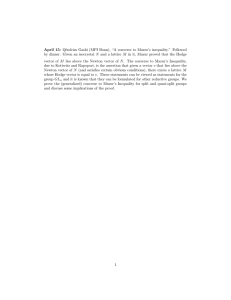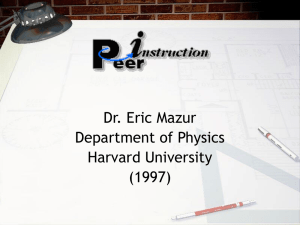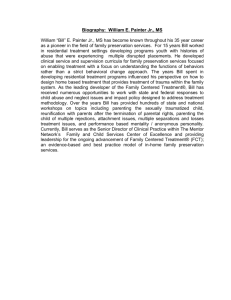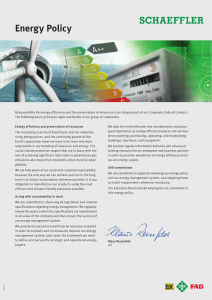PERSPECTIVES
advertisement
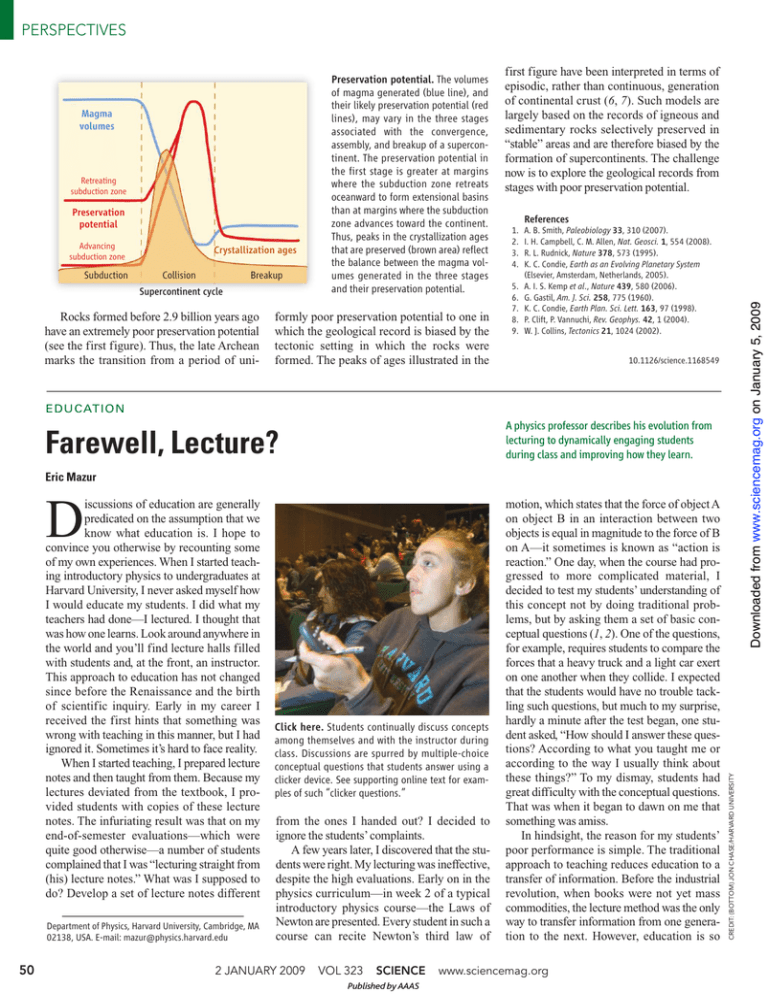
PERSPECTIVES Retreating subduction zone Preservation potential Advancing subduction zone Subduction Crystallization ages Collision Breakup Supercontinent cycle Rocks formed before 2.9 billion years ago have an extremely poor preservation potential (see the first figure). Thus, the late Archean marks the transition from a period of uni- formly poor preservation potential to one in which the geological record is biased by the tectonic setting in which the rocks were formed. The peaks of ages illustrated in the first figure have been interpreted in terms of episodic, rather than continuous, generation of continental crust (6, 7). Such models are largely based on the records of igneous and sedimentary rocks selectively preserved in “stable” areas and are therefore biased by the formation of supercontinents. The challenge now is to explore the geological records from stages with poor preservation potential. References 1. 2. 3. 4. 5. 6. 7. 8. 9. A. B. Smith, Paleobiology 33, 310 (2007). I. H. Campbell, C. M. Allen, Nat. Geosci. 1, 554 (2008). R. L. Rudnick, Nature 378, 573 (1995). K. C. Condie, Earth as an Evolving Planetary System (Elsevier, Amsterdam, Netherlands, 2005). A. I. S. Kemp et al., Nature 439, 580 (2006). G. Gastil, Am. J. Sci. 258, 775 (1960). K. C. Condie, Earth Plan. Sci. Lett. 163, 97 (1998). P. Clift, P. Vannuchi, Rev. Geophys. 42, 1 (2004). W. J. Collins, Tectonics 21, 1024 (2002). Downloaded from www.sciencemag.org on January 5, 2009 Magma volumes Preservation potential. The volumes of magma generated (blue line), and their likely preservation potential (red lines), may vary in the three stages associated with the convergence, assembly, and breakup of a supercontinent. The preservation potential in the first stage is greater at margins where the subduction zone retreats oceanward to form extensional basins than at margins where the subduction zone advances toward the continent. Thus, peaks in the crystallization ages that are preserved (brown area) reflect the balance between the magma volumes generated in the three stages and their preservation potential. 10.1126/science.1168549 EDUCATION A physics professor describes his evolution from lecturing to dynamically engaging students during class and improving how they learn. Farewell, Lecture? D iscussions of education are generally predicated on the assumption that we know what education is. I hope to convince you otherwise by recounting some of my own experiences. When I started teaching introductory physics to undergraduates at Harvard University, I never asked myself how I would educate my students. I did what my teachers had done—I lectured. I thought that was how one learns. Look around anywhere in the world and you’ll find lecture halls filled with students and, at the front, an instructor. This approach to education has not changed since before the Renaissance and the birth of scientific inquiry. Early in my career I received the first hints that something was wrong with teaching in this manner, but I had ignored it. Sometimes it’s hard to face reality. When I started teaching, I prepared lecture notes and then taught from them. Because my lectures deviated from the textbook, I provided students with copies of these lecture notes. The infuriating result was that on my end-of-semester evaluations—which were quite good otherwise—a number of students complained that I was “lecturing straight from (his) lecture notes.” What was I supposed to do? Develop a set of lecture notes different Department of Physics, Harvard University, Cambridge, MA 02138, USA. E-mail: mazur@physics.harvard.edu 50 Click here. Students continually discuss concepts among themselves and with the instructor during class. Discussions are spurred by multiple-choice conceptual questions that students answer using a clicker device. See supporting online text for examples of such “clicker questions.” from the ones I handed out? I decided to ignore the students’ complaints. A few years later, I discovered that the students were right. My lecturing was ineffective, despite the high evaluations. Early on in the physics curriculum—in week 2 of a typical introductory physics course—the Laws of Newton are presented. Every student in such a course can recite Newton’s third law of 2 JANUARY 2009 VOL 323 SCIENCE Published by AAAS motion, which states that the force of object A on object B in an interaction between two objects is equal in magnitude to the force of B on A—it sometimes is known as “action is reaction.” One day, when the course had progressed to more complicated material, I decided to test my students’ understanding of this concept not by doing traditional problems, but by asking them a set of basic conceptual questions (1, 2). One of the questions, for example, requires students to compare the forces that a heavy truck and a light car exert on one another when they collide. I expected that the students would have no trouble tackling such questions, but much to my surprise, hardly a minute after the test began, one student asked, “How should I answer these questions? According to what you taught me or according to the way I usually think about these things?” To my dismay, students had great difficulty with the conceptual questions. That was when it began to dawn on me that something was amiss. In hindsight, the reason for my students’ poor performance is simple. The traditional approach to teaching reduces education to a transfer of information. Before the industrial revolution, when books were not yet mass commodities, the lecture method was the only way to transfer information from one generation to the next. However, education is so www.sciencemag.org CREDIT: (BOTTOM) JON CHASE/HARVARD UNIVERSITY Eric Mazur PERSPECTIVES the level of understanding of the subject being discussed. I often meet people who tell me they have implemented this “clicker method” in their classes, viewing my approach as simply a technological innovation. However, it is not the technology but the pedagogy that matters (5). Unfortunately, the majority of uses of technology in education consist of nothing more than a new implementation of old approaches, and therefore technology is not the magic bullet it is often presumed to be. Although clickers offer convenience and (at least for now) an amount of trendiness that appeals to students, the method can be implemented with flash cards, which are inexpensive and never prone to technological glitches (6). Data obtained in my class and in classes of colleagues worldwide, in a wide range of academic settings and a wide range of disciplines, show that learning gains nearly triple with an approach that focuses on the student and on interactive learning (7, 8). Students are given the opportunity to resolve misunderstandings about concepts and work together to learn new ideas and skills in a discipline. Most important, students not only perform better on a variety of conceptual assessments, but also improve their tradi- tional problem-solving skills (9). Also, data show that such interactive engagement helps to reduce the gender gap that exists in introductory physics classrooms (10). So, evidence is mounting that readjusting the focus of education from information transfer to helping students assimilate material is paying off. My only regret is that I love to lecture. References and Notes 1. D. Hestenes, M. Wells, G. Swackhamer, Phys. Teach. 30, 141 (1992). 2. A version of (1) revised in 1995 by I. Halloun, R. Hake, E. Mosca, and D. Hestenes is available in (4). 3. D. Huff, How to Lie with Statistics (Norton, New York, 1954). 4. E. Mazur, Peer Instruction: A User’s Manual (Prentice Hall, Upper Saddle River, NJ, 1997). 5. M. K. Smith et al., Science 323, 122 (2009). 6. N. Lasry, Phys. Teach. 46, 242 (2008). 7. A. P. Fagen, C. H. Crouch, E. Mazur, Phys. Teach. 40, 206 (2002). 8. N. Lasry, E. Mazur, J. Watkins, Am. J. Phys. 76, 1066 (2008). 9. C. H. Crouch, E. Mazur, Am. J. Phys. 69, 970 (2001). 10. M. Lorenzo, C. H. Crouch, E. Mazur, Am. J. Phys. 74, 118 (2006). Downloaded from www.sciencemag.org on January 5, 2009 much more than just information transfer, especially in science. New information needs to be connected to preexisting knowledge in the student’s mind. Students need to develop models to see how science works. Instead, my students were relying on rote memorization. Reflecting on my own education, I believe that I also often relied on rote memorization. Information transmitted in lectures stayed in my brain until I had to draw upon it for an exam. I once heard somebody describe the lecture method as a process whereby the lecture notes of the instructor get transferred to the notebooks of the students without passing through the brains of either (3). That is essentially what is happening in classrooms around the globe. Since this agonizing discovery, I have begun to turn this traditional informationtransfer model of education upside down. The responsibility for gathering information now rests squarely on the shoulders of the students. They must read material before coming to class, so that class time can be devoted to discussions, peer interactions, and time to assimilate and think (4). Instead of teaching by telling, I am teaching by questioning. I now structure my time during class around short, conceptual multiple-choice questions. I alternate brief presentations with these questions, shifting the focus between instructor and students. The questions address student difficulties in grasping a particular topic and promote thinking about challenging concepts. After posing the question, I give the students 1 to 2 minutes to think, after which each must commit to an individual answer. They do this by submitting their answers using handheld devices called “clickers” (see the figure). Because of the popularity of these devices, questions posed this way are now often referred to as “clicker questions.” The devices transmit the answers to my computer, which displays the distribution of answers. If between 35% and 70% of the students answer the question correctly, I ask them to discuss their answers and encourage them to find someone in the class with a different answer. Together with teaching assistants, I circulate among the students to promote productive discussions and guide their thinking. After several minutes of peer discussion, I ask them to answer the same question again. I then explain the correct answer and, depending on the student answers, may pose another related question or move on to a different topic. This approach has two benefits: It continuously actively engages the minds of the students, and it provides frequent and continuous feedback (to both the students and the instructor) about Supporting Online Material www.sciencemag.org/cgi/content/full/323/5910/50/DC1 SOM Text 10.1126/science.1168927 MICROBIOLOGY Mosquitoes Cut Short Andrew F. Read1,2 and Matthew B. Thomas2 Can the life-shortening effect of a bacterium on mosquitoes control the transmission of dengue? F orty years ago, as the first drug- and insecticide-based global malaria eradication plan was being abandoned, the concept was raised of using evolutionary genetics to fight vector-borne diseases like malaria, dengue, and river blindness (1). The idea was to exploit selfish genetic elements, entities that can spread through host populations by distorting normal Mendelian inheritance, thereby enhancing their own transmission. Theoretically, such elements could be used to drive antipathogen effector genes through mosquito populations. On page 141 of this issue, McMeniman et al. (2) report a major step in a lateral development of this approach. They have infected the mosquito species that 1Center for Infectious Disease Dynamics, Department of Biology, Pennsylvania State University, University Park, PA 16802, USA. E-mail: a.read@psu.edu 2Center for Infectious Disease Dynamics, Department of Entomology, Pennsylvania State University, University Park, PA 16802, USA. www.sciencemag.org SCIENCE VOL 323 Published by AAAS transmit dengue viruses to humans with an inheritance-distorting bacterium that kills mosquitoes likely to be infectious. Wolbachia are maternally inherited bacteria found in a diverse range of arthropods. Because only female hosts can keep a lineage of Wolbachia alive, the bacteria have acquired mechanisms to ensure the overrepresentation of infected female offspring. One of these strategies is called cytoplasmic incompatibility, in which uninfected females that mate with Wolbachia-infected males fail to produce offspring. This reproductive asymmetry can allow the bacteria to spread through a population even if they reduce host fecundity (see the figure). Rapid invasion of fruit fly (Drosophila) populations by Wolbachia has been seen in real time in nature, raising the prospect of using these bacteria to spread disease-controlling genes through mosquito populations. 2 JANUARY 2009 51

